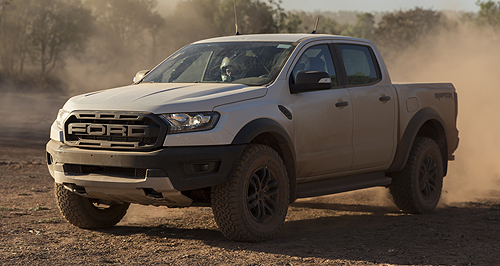News - Ford - Ranger - RaptorFord defends Ranger Raptor’s 2.0-litre engineCrowd pleaser: The Ranger Raptor’s 2.0-litre EcoBlue twin-turbocharged four-cylinder diesel engine develops 157kW of power at 3750rpm and 500Nm of torque from 1750 to 2000rpm. ‘Some customers really don’t care’ about Ranger Raptor’s small powertrain: Ford26 Jul 2018 FORD has fiercely defended its decision to offer the Ranger Raptor performance ute with a smaller-capacity engine than the 3.2-litre unit found in regular Ranger variants, which will soon gain access to the more potent 2.0-litre powertrain as an option.
Speaking to journalists this week at the Ranger Raptor international media launch at Tipperary Station in the Northern Territory Outback, Ford Asia Pacific vice-president of product development Trevor Worthington stressed that the wider availability of the Raptor’s engine – including for the Everest large SUV – does not hurt its overall appeal.
“It’s got the level of uniqueness that a Raptor needs to have,” he said. “We have this view that we want to offer the broadest range of powertrain choices to our customers, and we’re wedded to the experience that they’ve had.
“Our view would be that (with) the level of technology, the level of performance, the level of fuel economy that the engine offers married to the 10-speed gearbox, that powertrain – we are convinced – will become the powertrain of choice.
“Different markets have asked for different things. We’ve looked at all the engineering that we want to do.
“The opportunity to continue to make the (2.0-litre) engines available at the same time as the (3.2-litre units) just seemed like the right thing to do.”
When questioned why the Raptor is motivated by a 2.0-litre unit and not a higher-capacity engine, Mr Worthington explained that the former better catered towards customer needs.
“The point about power packs is that there are things that customers need to be delivered,” he said. “Those things relate to performance, they relate to the fuel economy, they relate to all the other attributes, like NVH (noise, vibration and harshness).
“As we look out into the future, we say given all of those challenges and CO2 and all those things, you roll them all into a ball and you say: ‘what’s the best outcome that’s going to deliver what the customer wants’.
“This power pack has got more performance, more fuel economy. It’s got better attributes. It’s lighter. It ticks the boxes for everything that the customers want.
“There’s this thing called engine capacity, which some customers get hung up on, some customers really don’t care. At the end of the day, people have got to drive the car and experience it.
“We’re very, very comfortable that as the industry globally moves forward, downsizing, boosting and putting technology into cars that deliver the attributes our customers are looking for is an inevitable trend. This is part of that. It’s just another piece of that journey.”
Mr Worthington suggested that a petrol engine, like the 336kW/691Nm 3.5-litre EcoBoost twin-turbocharged V6 found in the F-150 Raptor, was not considered in the development process due to the established global demand for diesel-powered Rangers.
“We looked for the best overall power pack that our global customers we’re going to need,” he said. “If you look at Ranger, the vast majority of Rangers around the world are sold with diesel engines.
“If you look across all the markets, the 200 markets we sell Ranger in, 99.3 per cent of them are diesel. So, (it had to be) the best diesel power pack that we could find.”
Mr Worthington ruled out considering a higher-displacement version of the Raptor for the Australian market due to its sensitivity towards smaller performance engines.
“That question never occurred to us,” he said. “That’s a very Australian perspective, and that question was never part of our process.
“When you’re either driving it to the off-road or driving it back from the off-road, or you’re just using it in its every-day guise, this vehicle will deliver everything that our customers are looking for, including fuel economy.
“Is this vehicle going to be for everybody? Absolutely not. (It’s) for those people that are looking for, frankly, a different version of performance. For those that want the traditional blacktop, then we sell variations of Mustang.”
When questioned by GoAuto if Ford Asia Pacific is expecting some difficulty marketing the Raptor due to its engine size, Mr Worthington confessed he was not sure what the impact will be.
“Honestly, I don’t know,” he said. “This is the kind of vehicle that we won’t be leading with the powertrain, we won’t be leading with any particular technical element other than the overall package.
“If you were in a vehicle with a different kind of engine, you would have a different kind of experience, but that wouldn’t necessarily make it a better experience.
“Are you people not going to buy it because it doesn’t have a 7.0-litre V12 in it? I wouldn’t have thought.
“This vehicle is much more about the capability of the chassis, and I accept that’s a different message … if the punter wants it, they’ll buy it. If they don’t want it, they’ll go buy something else.”
Ford Ranger Raptor chief program engineer Damien Ross added that the Raptor’s off-road DNA includes several requirements, with the Ranger version developing enough power and torque to meet those standards alongside increasingly stringent efficiency regulations.
“We look at the whole package,” he said. “We don’t look at what people are going to think … because with Raptor, the character is already written for us in the Raptor DNA.
“Ford Performance have very nicely provided us an easy way to pull together a fantastic vehicle, and that’s what we’ve done.
“When you get into the vehicle and take it off-road, I think that’s when it’s as much fun as you can probably handle.”
When questioned by GoAuto if a possible US-market Ranger Raptor could open the door for a petrol unit in Australia down the track, Mr Ross declined to comment but admitted “certainly their tastes are gasoline”.
As previously reported, the Raptor’s aforementioned EcoBlue engine is a twin-turbocharged four-cylinder diesel unit that produces 157kW of power at 3750rpm and 500Nm of torque from 1750 to 2000rpm.
These outputs are achieved by a smaller high-pressure turbocharger with variable geometry that kicks in at lower engine speeds, while a larger sequential low-pressure unit with fixed geometry spools up deeper into the rev range.
Conversely, the regular Ranger’s 3.2-litre single-turbo five-cylinder diesel engine delivers 147kW at 3000rpm and 470Nm from 1750 to 2500rpm.
XLT and Wildtrak variants of the updated Ranger will become available with the 2.0-litre unit as a $1200 option, while pricing for the mechanically related Everest facelift is yet to be released. Both models are due for launch later this year.
The Raptor sends drive part-time to all four wheels via a dual-range transfer case and a 10-speed torque-convertor automatic transmission – co-developed with rival General Motors – with magnesium paddle shifters.
As a result, the 2404kg Raptor can sprint from standstill to 100km/h in 10.5 seconds while on the way to its top speed of 170km/h, besting the volume-selling Wildtrak dual-cab pick-up by about half a second but about three seconds off the pace of the 190kW/550Nm Mercedes-Benz X350d and 200kW/580Nm Volkswagen Amarok TDI580.
Claimed fuel consumption on the combined cycle test is 8.2 litres per 100 kilometres for the Raptor, while its carbon dioxide emissions have been tested at 212 grams per kilometre. Comparatively, the Wildtrak dual-cab pick-up is 0.7L/100km thirstier and 22g/km more pollutant.  Read more25th of July 2018  Driven: Ford Ranger Raptor misses AEB – for nowAutonomous emergency braking on hold for incoming Ford Ranger Raptor flagship8th of June 2018  Raptor more than just powertrain: FordFord rakes up about 1000 Raptor orders despite Ranger and Everest gaining powertrain24th of May 2018  $1200 premium for new Ford Ranger dieselFord announces prices for new-look, trimmed Ranger line-up due in September16th of May 2018  Ford outs facelifted 2019 RangerRaptor’s 157kW diesel engine to be available in two more Ford Ranger variants9th of April 2018  Ford Ranger Raptor to be priciest ute in Oz$74,990 BOCs price positions Ford’s Ranger Raptor at top of one-tonne pick-up pack13th of February 2018  Ford Ranger Raptor could be priciest ute in OzFord’s hi-po Ranger Raptor expected to rocket to top of dynamite dual-cab segment12th of February 2018  Ranger Raptor is a fully fledged performance car – FordForthcoming Ranger Raptor 4x4 dual-cab ute can do it all, claims Ford8th of February 2018  Petrol “not considered for Ford Ranger Raptor”Ford Performance targeted twin-turbo two-litre diesel for Ranger Raptor from day one7th of February 2018  Ford gambles on smaller diesel for Ranger RaptorFord downsizes to 2.0-litre diesel for its new top-spec Ranger Raptor dual-cab ute |
Click to shareFord articlesResearch Ford Ranger pricing
Motor industry news |















Facebook Twitter Instagram